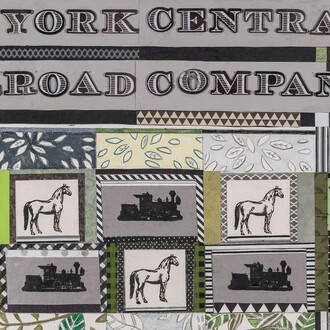Viridian Artists is pleased to present " Director's Choice: From Virtual To Actual 6", curated by Vernita Nemec, Viridian’s director, featuring a selection of artists who entered our 27th International Juried Competition in 2016, curated by Tumelo Mosaka.
Although these artists were not “winners” of Viridian's 24th International Juried Competition, their art is uniquely interesting and was of particular interest to Nemec. Viridian's “Director's Choice” Exhibitions arise from one of Viridian's primary missions: to provide meaningful exposure to under-known artists of all ages whose art merits wider attention.
Each of the 15 artists in this diverse exhibition has her or his personal obsession that serves as the starting point for their artistic search to transform inner concerns into an outer reality. The results of transforming these realities into art, remains open to each viewer's interpretation and becomes the first translation of the virtual into the actual. The second translation is the opportunity to see the art in the flesh instead of in a powerpoint presentation as the art were seen in the Juried Competition in 2016.
Below, many of the artists speak for themselves about their motives and intentions in the work. For those that are silent, the viewer is invited to look more closely at the work for clues into the whys. Andrea Barnes: "The most recent in an ongoing series of exploratory mixed media works which are reflective of my experience and influenced by my interests in science, music, and the process of memory. David Bartlett: “In its decay, Eastern State Penitentiary strikingly reveals its elemental physicality. In lingering monuments and temples, stone and iron celebrate endurance of the human spirit. Here is brute incarceration - bleak, iterated enclosures with mocking slits of sky and shabby rusted remnants of meager furnishings.
Nancy Brown: “My image-making privileges “found” over “sought”, enigmatic over declarative, less over more. My photographic images – radically de-focused, indeterminate, liminal – encourage a kind of free-flowing inquiry that stimulates new ways of seeing and looking, critical thinking, and play.” Jeannette Cherry strives to create paintings that are complex, yet simple. She enjoys intuitive risk-taking, interspersed with thoughtful analysis that she feels resembles an order that holds “just barely”. She wants to keep uncovering the endless connections between control and free-falling – Deb Flagel, after being both a winner in the 28th Juried Competition & Director’s Choice, she is also now a part of Viridian Artists as well as the director of Woman Made Gallery in Chicago. "My work is an accumulation of momentary glances encountered on a daily basis. As my eye records the environmental landscape that surrounds me, my mind begins to weave line, color and shape, constructing a sort of self identity...a personal cultural fabric."
Marcella Hackbardt: feels the "subject" of this series would not be clear to an observer upon seeing just one piece, but can be felt. Beginning with photographs of her son, his strangely known and unknown body, is overlaid her watchfulness, worries, tendernesses, and the real and symbolic distance that comes with his independence.
Maki Hajikano: The advances of science have given us a new perspective of the body. My piece suggests various cell forms and mutation process, which was inspired by the introduction of IPS cells. Through the work I challenge and play with people’s notions about form as well as sexuality, since in some cultures the phallic form does not necessarily imply negative connotations.
Ed Herman: Sokov= Socks Off. Leonid Sokov is/was a member of the Russian art movement, Sotz Art, the Russian version of Pop ART. Before coming to the US, the Russian authorities bulldozed a work of his, Very Hard Criticism. Finally he represented Russia in the 2014 Venice Biannual.
For Jeannine Hunter Lazzaro there is and has always been a fascination in creating images that explore the surface and medium of the picture plane. Combining various methods, textures and paint to create becomes a transformative experience for her. Particularly stain-painting, masking out areas, creating collaged surfaces and shaping the canvas are elements she has developed in her visual language.
Barbara Hillerman Lieske’s career path spanned graphic design, craft art, art education, research dealing with the sociology of fashion, and photography. Her interest in street photography evolved while serving in Vienna, Austria, as head of a branch of Webster University's Art Department. “As I walked through the city I was attracted to individuals who expressed their personalities and humanity through gesture and choice of clothing.”
Leonard Rosenfeld (1926-2009), as an Expressionist painted, in his words, "with a weird combination of abandon and discipline." "Frankenstein in Baghdad" (2006), was among his Iraq War series. The series was first inspired by a New York Times review of In the Company of Soldiers by Rick Atkinson, which spoke of General Petraeus' precient question to Atkinson, "Tell me how this ends?" Rosenfeld's Iraq War series spanned 2004-2008.
Jimmy Salmon: Study in Old World Still Life: The photograph in this exhibition, GRAPES, BERKEMEYER AND ROEMER, is from a series based on a study of the 17th Century Dutch Still Life painters Pieter Claesz, Adriaen Coorte, and the more rustic work of Spaniard Luis Mendelez. The intent of the work was to create a meditative mood, using simple compositions, with hand painted backgrounds of brush strokes and color pallet to resemble those of Claesz.
Nela V. Steric: "The "Virgin of the Rocks" is a part of my "Spiritual" Series paintings. In the series, I explore my relationship with the "other side", my beliefs, but also my doubts and the underlying irony in the religious stories that people create to explain the spiritual."
Rosalind Tobias: “I love working from a live model. I love the challenge of capturing the essence of a pose. One is working with very deep feelings.”
Jeff Watts shot the Central Park Row Boats “as I was intrigued by the their patterns of shape and color and thought they would make for an interesting abstract image which would not be immediately recognizable to the viewer.”
















